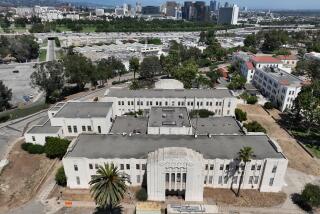Newest Washington memorial honors wounded veterans
The story that Lois Pope likes to tell about her first interaction with war-wounded veterans takes place at a rehabilitation center in New York in the mid-1960s.
Pope, an actress who had performed on Broadway, had been invited to sing there. Her audience was slumped in wheelchairs and resting on gurneys.
In a rendition of “Somewhere” from “West Side Story,” she sang the line “Hold my hand and I’ll take you there,” and reached out to a young Vietnam veteran to take his hand.
“But he had no hand to hold,” says Pope, now 81.
She describes the experience as the emotional seed of her drive to build a national memorial for disabled veterans.
This Sunday in Washington, thousands of veterans are expected to attend the dedication of the American Veterans Disabled for Life Memorial. President Obama is scheduled to speak.
More than $10 million of the $80-million cost of the memorial came from Pope, who is the widow of National Enquirer founder Generoso Pope Jr. The rest was raised through a foundation she helped found.
The advocacy group Disabled American Veterans donated about $10 million. H. Ross Perot, the businessman and two-time presidential candidate, chipped in $3 million. More than a million individuals contributed, along with corporations.
The memorial covers a 2.4-acre triangle next to the U.S. Botanical Garden between 2nd Street and Washington Avenue. A single flame sits inside a five-pointed star, and a membrane of water coats an expanse of granite. The main structure is abutted by a grove of ginkgo biloba trees and 47 thick glass panels embedded with war photographs and etched with quotations.
“In war, there are no unwounded soldiers,” says one, from the Argentine writer Jose Narosky.
“It’s a living memorial,” said Michael Vergason, the landscape architect whose firm won a competition to design it. “It’s about reflection.”
Though Pope, a well-known philanthropist in south Florida, describes herself as apolitical, she said the memorial is fundamentally antiwar. It is no accident that she helped choose a location near the Capitol building.
“Congress and elected representatives will pass there, and maybe they’ll think twice before we go to war,” she said.
More than 3.7 million veterans receive monthly disability pay for medical conditions incurred in the military. Nearly any ailment that occurred during service is eligible for compensation, including those that occurred during peacetime or off-duty. But Pope said her intention has always been to honor veterans, living and dead, who have suffered the physical and psychological wounds of war.
Starting with the Civil War, about 1.6 million U.S. troops have been wounded in action over the last 154 years, according to the Pentagon (which did not include Confederate soldiers in the statistics).
Roughly 69,000 have had limbs amputated, including more than 2,000 in the recent wars in Afghanistan and Iraq.
Millions more suffer from post-traumatic stress disorder, which did not become an official diagnosis until 1980.
Pope said she came up with the idea for a memorial in the mid-1990s during a visit to the Vietnam Veterans Memorial to find the name of a cousin who was killed in the war.
She said she telephoned the VA for five months before being put through to then-Secretary Jesse Brown. He brought in Art Wilson, head of Disabled American Veterans.
“When she came to us, I was taken aback,” Wilson said. “Who was this nice lady and philanthropist?”
Together, the three launched the foundation and embarked on the steps required by the government to build a national memorial.
Pope, who grew up in suburban Philadelphia and now lives in Manalapan, Fla., said she spent weeks driving around Washington with U.S. Park Service rangers until she settled on the site.
In 2000, President Clinton signed a bill authorizing the memorial.
The law stipulated that no federal money could be spent on the project. Wilson said the 2001 terrorist attacks significantly set back fundraising efforts.
“There were a lot of people raising money,” he said. “The competition was very stiff.”
When Pope asked Perot to donate, she said, he questioned whether a memorial was the best way to help disabled veterans.
She eventually convinced him that raising awareness was a worthy cause.
Pope said that even though the U.S. has repeatedly gone to war during her lifetime, she long remained largely insulated from the human toll.
“Nobody ever told me about the struggles and sacrifices these men had made for our liberty,” she said.
Twitter: @AlanZarembo
More to Read
Sign up for Essential California
The most important California stories and recommendations in your inbox every morning.
You may occasionally receive promotional content from the Los Angeles Times.











